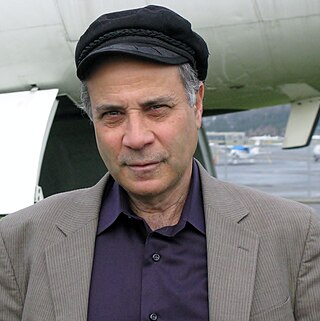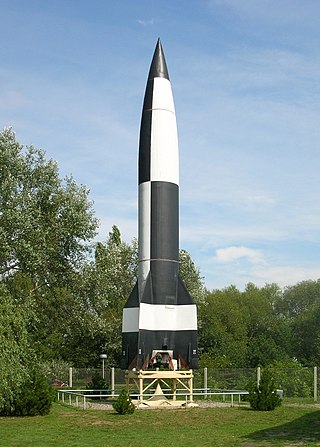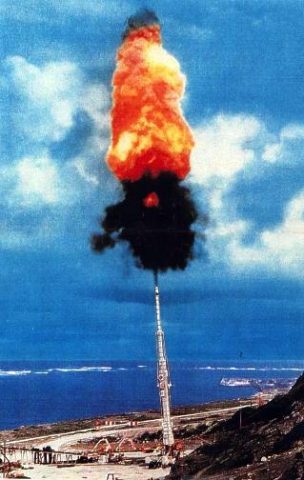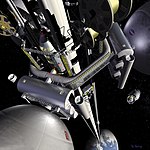
Aeronautics is the science or art involved with the study, design, and manufacturing of air flight-capable machines, and the techniques of operating aircraft and rockets within the atmosphere. While the term originally referred solely to operating the aircraft, it has since been expanded to include technology, business, and other aspects related to aircraft. The term "aviation" is sometimes used interchangeably with aeronautics, although "aeronautics" includes lighter-than-air craft such as airships, and includes ballistic vehicles while "aviation" technically does not.

Konstantin Eduardovich Tsiolkovsky was a Russian rocket scientist who pioneered astronautics. Along with Hermann Oberth and Robert H. Goddard, he is one of the pioneers of space flight and the founding father of modern rocketry and astronautics. His works later inspired Wernher von Braun and leading Soviet rocket engineers Sergei Korolev and Valentin Glushko, who contributed to the success of the Soviet space program. Tsiolkovsky spent most of his life in a log house on the outskirts of Kaluga, about 200 km (120 mi) southwest of Moscow. A recluse by nature, his unusual habits made him seem bizarre to his fellow townsfolk.

Robert Zubrin is an American aerospace engineer, author, and advocate for human exploration of Mars. He is also an advocate for U.S. space superiority, writing that "in the 21st century, victory on land, sea or in the air will go to the power that controls space" and that "if we desire peace on Earth, we need to prepare for war in space."

A rocket is a vehicle that uses jet propulsion to accelerate without using any surrounding air. A rocket engine produces thrust by reaction to exhaust expelled at high speed. Rocket engines work entirely from propellant carried within the vehicle; therefore a rocket can fly in the vacuum of space. Rockets work more efficiently in a vacuum and incur a loss of thrust due to the opposing pressure of the atmosphere.

Spacecraft propulsion is any method used to accelerate spacecraft and artificial satellites. In-space propulsion exclusively deals with propulsion systems used in the vacuum of space and should not be confused with space launch or atmospheric entry.

The V2, with the technical name Aggregat 4 (A4), was the world's first long-range guided ballistic missile. The missile, powered by a liquid-propellant rocket engine, was developed during the Second World War in Nazi Germany as a "vengeance weapon" and assigned to attack Allied cities as retaliation for the Allied bombings of German cities. The V2 rocket also became the first artificial object to travel into space by crossing the Kármán line with the vertical launch of MW 18014 on 20 June 1944.

Gerald Vincent Bull was a Canadian engineer who developed long-range artillery. He moved from project to project in his quest to economically launch a satellite using a huge artillery piece, to which end he designed the Project Babylon "supergun" for Saddam Hussein's government in Iraq.

Robert Hutchings Goddard was an American engineer, professor, physicist, and inventor who is credited with creating and building the world's first liquid-fueled rocket, which was successfully launched on March 16, 1926. By 1915 his pioneering work had dramatically improved the efficiency of the solid-fueled rocket, signaling the era of the modern rocket and innovation. He and his team launched 34 rockets between 1926 and 1941, achieving altitudes as high as 2.6 km (1.6 mi) and speeds as fast as 885 km/h (550 mph).

Operation Paperclip was a secret United States intelligence program in which more than 1600 German scientists, engineers, and technicians were taken from former Nazi Germany to the U.S. for government employment after the end of World War II in Europe, between 1945 and 59. Most were former members and leaders of the Nazi Party.

Project HARP, for high altitude research project, was a joint venture of the United States Department of Defense and Canada's Department of National Defence created with the goal of studying ballistics of re-entry vehicles and collecting upper atmospheric data for research. Unlike conventional space launching methods that rely on rockets, HARP instead used very large guns to fire projectiles into the atmosphere at extremely high speeds.

A space gun, sometimes called a Verne gun because of its appearance in From the Earth to the Moon by Jules Verne, is a method of launching an object into space using a large gun- or cannon-like structure. Space guns could thus potentially provide a method of non-rocket spacelaunch. It has been conjectured that space guns could place satellites into Earth's orbit, and could also launch spacecraft beyond Earth's gravitational pull and into other parts of the Solar System by exceeding Earth's escape velocity of about 11.20 km/s. However, these speeds are too far into the hypersonic range for most practical propulsion systems and also would cause most objects to burn up due to aerodynamic heating or be torn apart by aerodynamic drag. Therefore, a more likely future use of space guns would be to launch objects into Low Earth orbit, at which point attached rockets could be fired or the objects could be "collected" by maneuverable orbiting satellites.

Annie Easley was an African American computer scientist and mathematician who made critical contributions to NASA's rocket systems and energy technologies.
The Super High Altitude Research Project was a U.S. government project conducting research into the firing of high-velocity projectiles high into the atmosphere using a two-stage light-gas gun, with the ultimate goal of propelling satellites into Earth orbit. Design work on the prototype space gun began as early as 1985 at the Lawrence Livermore National Laboratory in California and became operational in December 1992. It is the largest gas gun in the world.

Half-Life 2: Episode Two is a 2007 first-person shooter game developed and published by Valve. Following Episode One (2006), it is the second of two shorter episodic games that continue the story of Half-Life 2 (2004). Players control Gordon Freeman, who travels through the mountains surrounding City 17 to a resistance base with his ally Alyx Vance. Like previous games in the series, Episode Two combines shooting, puzzle-solving and narrative elements, but adds expansive environments and less linear sequences.

Non-rocket spacelaunch refers to theoretical concepts for launch into space where much of the speed and altitude needed to achieve orbit is provided by a propulsion technique that is not subject to the limits of the rocket equation. Although all space launches to date have been rockets, a number of alternatives to rockets have been proposed. In some systems, such as a combination launch system, skyhook, rocket sled launch, rockoon, or air launch, a portion of the total delta-v may be provided, either directly or indirectly, by using rocket propulsion.

The space policy of the Barack Obama administration was announced by U.S. President Barack Obama on April 15, 2010, at a major space policy speech at Kennedy Space Center. He committed to increasing NASA funding by $6 billion over five years and completing the design of a new heavy-lift launch vehicle by 2015 and to begin construction thereafter. He also predicted a U.S.-crewed orbital Mars mission by the mid-2030s, preceded by the Asteroid Redirect Mission by 2025. In response to concerns over job losses, Obama promised a $40 million effort to help Space Coast workers affected by the cancellation of the Space Shuttle program and Constellation program.
Quicklaunch is an inactive US company attempting to use a type of space gun to launch payloads into low Earth orbit. It is a university spin-off of the SHARP project which ended 2005.
Metroid is a series of nonlinear science fiction action games published by Nintendo, featuring side-scrolling, metroidvania, and first-person shooter elements. The player character and protagonist of the series is Samus Aran, a space-faring bounty hunter who battles Space Pirates and a species called the Metroid.

The Japanese space program originated in the mid-1950s as a research group led by Hideo Itokawa at the University of Tokyo. The size of the rockets produced gradually increased from under 30 cm (12 in) at the start of the project, to over 15 m (49 ft) by the mid-1960s. The aim of the original research project was to launch a man-made satellite.

Since the founding of SpaceX in 2002, the company has developed four families of rocket engines — Merlin, Kestrel, Draco and SuperDraco — and since 2016 developed the Raptor methane rocket engine and after 2020, a line of methalox thrusters.

















